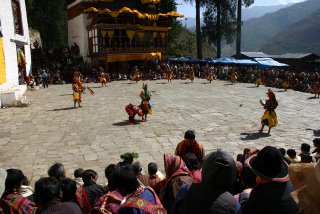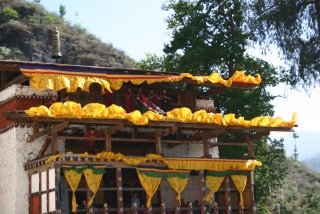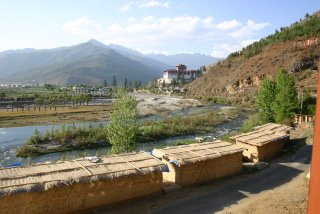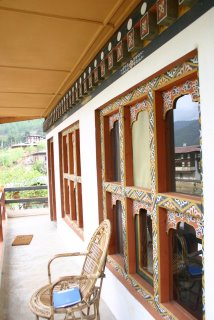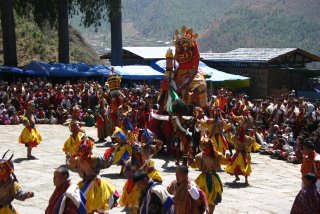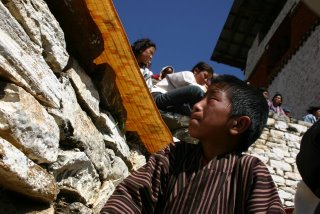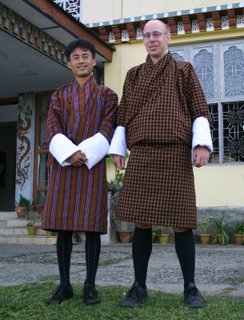 Tomorrow, I'll be teaching my second class. I was drawing a keyboard today - so will see how it'll work out.
Tomorrow, I'll be teaching my second class. I was drawing a keyboard today - so will see how it'll work out.
Friday, April 28, 2006
I'm Feeling like a little kid ...
 Tomorrow, I'll be teaching my second class. I was drawing a keyboard today - so will see how it'll work out.
Tomorrow, I'll be teaching my second class. I was drawing a keyboard today - so will see how it'll work out.
Thursday, April 27, 2006
Teaching...
My class has 37 students and I have access to a lab with 11 computers for an hour once a week. I guess that's the point where you have to become creative and find new ways; I'll probably try to build a cardboard version of Word. But the first task is to build a large cardboard keyboard. Today, I started out with a comparison of humans and computers; what are computers good at and what are humans good at. Yeah Raimond, it's material I copied from your introductory lesson @ Kanti Baden ;-). I'm not quite sure whether I was able to bring my point across - I'll discover it on Saturday - the day when the next meeting will take place. Yeah, folks are working on Saturday - at least from 8am to 12pm.
To get a better understanding about the knowledge of the students, I asked a few questions. I'd like to share the results with you:
- 2 (out of 37) have a computer at home
- both of them have as well an internet connection
- 10 had access to computers in the school that they attended before they came to NIE
- 10 can create a folder
- 11 can create a MS Word document
- Nobody knows what a 'tab stop' is.
- Nobody can create an enumerated list (I assume that the question wasn't asked clearly enough...)
- 13 know how to create a table in MS Word
- 11 know how to create a paragraph
- 2 know how to get double line spacing in MS Word
It's so difficult to explore how stuff really is. In the Bhutanese culture, it is extremely important not to loose countenance. So you might get three different answer to the same question - depending on how good your relation with the person you are asking is and how he or she is affected by the answer. For some things, you probably have to do it yourself to really discover how things actually are. That's the reason why it is really good to teach this class. You might argue that it is not sustainable to teach that class myself - once I'm gone, I'm gone. I agree. But without actually teaching the class, I would never have found out about the fact that the class has access to the computer lab only once a week. Or that only two of them have a computer at home.
How would you teach this class? Build a cardboard version of Word? What fundamental concepts would you teach to students that haven't touched a computer so far? What should I keep in mind? Please feel free to add comments to this post ;-).
Everybody was waiting for the pic; so here is a first one - together with Cheku - he helped out last Sunday to get vegetables. Luckily, the pic shows only part of my body... but I promise to post one where you can see the whole body (with knee socks...).
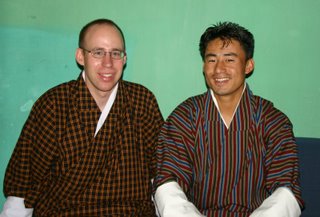
Tuesday, April 25, 2006
Still wearing a Gho
Tomorrow, I'll be leading the IT student club meeting and will give an introduction into 'how to search for stuff on the web'. We'll see how it'll work out. I won't have a lot of time so I'll basically give a few questions about Switzerland and they are requested to search for a few minutes. Then we'll collect their results and how they got those results. In the next meeting, I'll try to show different strategies based on what they came up with. We'll see how well it'll work...
On Thursday, I'll be teaching my first FIT (computer literacy - a bit of Word) class. I'm excited to do that! It's not only a good experience for myself but it is as well a good way of better realizing how things here in Bhutan work and where possible problems could be. For some of the students it'll be their first contact with a computer so I'll probably need a slow start.
Monday, April 24, 2006
Washing clothes and buying a Gho
O shuut, that's how you're doing it in good ol' Switzerland. In Bhutan, you have to modify those instructions a little bit: Collect them (free them from ants if necessary), fill a bucket with hot water, add detergent, put clothes into the bucket, use your hands to simulate a washing machine, fill the bucket with cold water, use again your hands, build construction to dry the clothes, hang them up, wait...
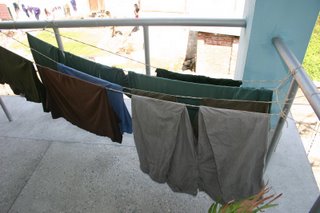 You see, I'm not getting bored. Besides washing clothes the hard way, I did a few other things during the weekend - all of them preventing me from posting ;-). Saturday, I helped redesigning the distance education web site for NIE Samtse. As it is always true for such things, it takes a lot longer than you thought in the beginning it would. At 3:30pm, we (Sonam Rinchen - a lecturer at NIE Samtse - and myself) went to the Indian part of Samtse (known as Checkpost) and ordered two Ghos (a Gho is the traditional Bhutanese dress). They measured my body and told us that we can pick it up Sunday at 4pm. In the evening, there was a cultural performance - everything in Dzongkha - so I didn't understand a whole lot. Still, it was very interesting and I enjoyed it a lot.
You see, I'm not getting bored. Besides washing clothes the hard way, I did a few other things during the weekend - all of them preventing me from posting ;-). Saturday, I helped redesigning the distance education web site for NIE Samtse. As it is always true for such things, it takes a lot longer than you thought in the beginning it would. At 3:30pm, we (Sonam Rinchen - a lecturer at NIE Samtse - and myself) went to the Indian part of Samtse (known as Checkpost) and ordered two Ghos (a Gho is the traditional Bhutanese dress). They measured my body and told us that we can pick it up Sunday at 4pm. In the evening, there was a cultural performance - everything in Dzongkha - so I didn't understand a whole lot. Still, it was very interesting and I enjoyed it a lot.On Sunday, I went to the market. The vendors at the market are mostly Indian guys and they don't speak English very well - and I don't speak Hindi. I thought 'well, it'll work out' - and in fact it did. Walking down to the market, I met a trainee from the NIE and he offered to help me out. So he helped buying all the stuff that I needed, bargained, and advised. After having done that, we went to a restaurant and got tea and Momos (a traditional Bhutanese dish).

In the afternoon, we went another time to the Checkpost and tried to get my first Gho. Well, it was promised that we'll get it at 4:30pm - but in the end, we got it at 6:30pm... So instead of just sitting there and waiting, we were walking around, getting tea, observed cows that walked in front of the store and a truck with at least 30 men on it, and a ton of other things that I'm not used to...
Once the Gho was ready, putting it on was - well - an adventure to say the least. Sonam helped a lot and finally, it worked out. This morning, I had to put it on myself. A disaster. I'm not telling you how long I tried without getting a really good result. In the end, I went to the office with a not-so-perfectly-sitting Gho. After an hour, a student dropped by and he was kind enough to help me out putting it on correctly... When I went to the canteen to order lunch, students kind of started laughing (ok, I had to laugh in the first place because it felt just so strange) - and actually, one of them gave me a few additional hints (and help out right away to put them into practice).
So you want to see a picture of me in a Gho?? I guess you'll have to wait a bit...
Friday, April 21, 2006
Assume...
The situation in Bhutan is a bit different. There are still villages that don't have access to a phone. The next phone is not just a ten minutes walk away but it might be rather a few hours or even two or three days. Can you imagine to walk a few days to call somebody?
Part of my work here in Bhutan is to look into distance education and how IT could be used. The NIE Samtse has a distance education program for teachers in the field. Teachers that are currently teaching but that feel the need to get an upgrade in their education can participate in this program. The participants in the distance education program stay at NIE Samtse for about 4 weeks per year to have a face-to-face communication with their lecturers and will study independently during the rest of the year (besides teaching fulltime - but that's a different story). Assignments are handed in with the help of the Bhutanese postal service and if a trainee has a question, he either writes an email, calls the lecturer, or sends a letter. One round of communication by letter might take up to 6 weeks.
About 64% of the students currently enrolled in distance education have access to computer and internet within reasonable distance - so within a few minutes walk. For 13% of the students, a manageable trip will bring them to a computer with internet connection. Manageable trip means to walk or drive for a few hours - but less than a day. For 24% of the students currently enrolled in distance education, neither of the above two categories applies. That means that they have to travel for more than one day to reach the next computer with internet connection. The closest computer with an internet connection might be located at a Resource Study Center (RSC). RSCs have been established in remote regions of Bhutan to help students collect material and communicate with the lecturers. The RSCs have fax, phone, a computer, a printer, and support staff.
So let's assume that you are a participant in the distance education program and you have been walking for the last two days to get to resource center. At the time you arrive at the resource center, you cannot start the computer because it is cloudy and the solar panels aren't producing electricity. You wait for a few hours and suddenly, we have blue sky and sun. You start the computer but upon trying to check your mails, you realize that the internet connection isn't available. The support staff investigates and concludes that it'll probably take a few days to get it working again. So here you are: you have been walking for a few days and haven't been able to make any use of the IT part of the distance education program.
That are the constraints that we are facing. Remember my introduction? 10 minutes walking to check your mails! A few days walking to check your mails?!? You might now understand why I have to take my time to get started in this new environment. I'm not judging but it's me that has to get adapted to a new environment, shift my way of thinking from my previous environment into the environment encountered here in Bhutan.
Thursday, April 20, 2006
Running during Rain is a Bad Idea
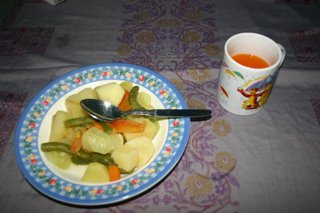
Wednesday, April 19, 2006
... and Sun
A few hours ago, I got an electronic copy of the grade report from my university. I was almost sure that I miserably failed one of the classes (randomized algorithms). Turns out that I got a 5.75 (6 maximum, 4 passing)...
Ok, let's finish for today. Just wanted to share with you the views from my room. In the front, you see the NIE campus and Bhutan - in the back, we have India.
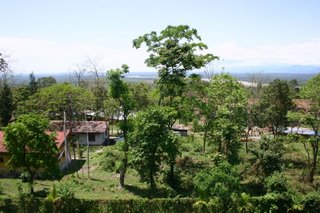
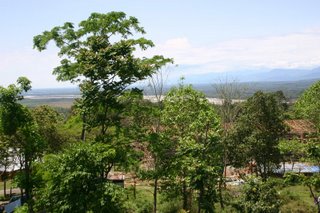
Rain...

Monday, April 17, 2006
Getting Started in Samtse
After the meeting, we (David, David's wife - whose name I haven't yet gotten..., Namgay, and another guy from NIE (again whose name I wasn't yet able to remember...)) went to shop. Shopping in Switzerland or the US is pretty boring; you see from the beginning what is available. Shopping in India (we crossed the border to shop) is a real adventure. There is no way of knowing what will be available. It's a matter of hours to find the thing that you actually are looking for. I have no idea how I should by stuff without the help of folks from NIE Samtse. So let me give you an example: This morning, I had already a ton of ants in my kitchen. All over the bread, the rice, the pasta - just every possible place. It's kind of obvious because I didn't have real closed containers for the food - only plastic bags. So one thing that I had to get today was closed containers. Not an easy thing. In the end I ended up with two containers that were originally planned to store food - and with about four containers that contained sweets in their former life. But hey, it works out!
I'm getting hungry and it's getting dark; so I'll be back during the next days. And by the way: Meanwhile, I have made the ants leave...
Sunday, April 16, 2006
First Day in Samtse
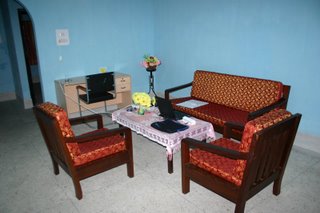
Saturday, April 15, 2006
Trip to Samtse
For the rest of the trip, I joined Kinzang and his cousin. Kinzang is a biology teacher at NIE Samtse. The road was quite winding and I had to concentrate quite a bit to make sure that I weren't getting sick. In the picture, you can see a typical Bhutanese road:
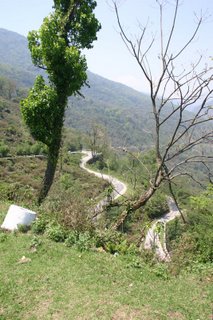
Sometimes, it's really difficult for two vehicles to cross; so just relax and take your time!
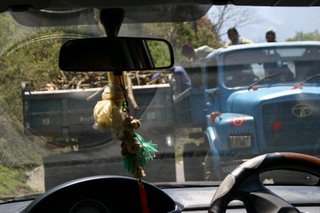 After 4 hours in the car, we arrived in Phuentsholing. We met Kinzang's extended family (sisters) and had lunch. After that, we went via India to Samtse. Leaving Bhutan and entering into India was coupled with some immigration problems but in the end it worked out. The drive through the Indian part was - let's say - a new world. Totally different from Bhutan. It's India; a ton of bikes everywhere, folks walking, and all those trucks with the writing 'Blow Horn' on the back. And oh yes; that's what we did: blow our horn! I'm happy that I didn't have to drive!
After 4 hours in the car, we arrived in Phuentsholing. We met Kinzang's extended family (sisters) and had lunch. After that, we went via India to Samtse. Leaving Bhutan and entering into India was coupled with some immigration problems but in the end it worked out. The drive through the Indian part was - let's say - a new world. Totally different from Bhutan. It's India; a ton of bikes everywhere, folks walking, and all those trucks with the writing 'Blow Horn' on the back. And oh yes; that's what we did: blow our horn! I'm happy that I didn't have to drive!Arriving at NIE Samtse, I met a lot of folks; to many to remember all the names. But I'll catch up on that! Samtse feels like - you'll laugh - like UNC. It has the same feeling, a similar climate, southern hospitality. Although I have been walking around campus only at night, I got the impression that there seems to be a nice small campus. My room is rather nice and I'll share an apartment with David Laird, an Australian guy. He and his wife will be arriving Sunday night.
Friday, April 14, 2006
Unfolding the Thondrol and moving to Samtse
The unfolding of the Thondrol was Thursday morning. I was invited to join the family of one of the IT lecturers here at the NIE Paro and we were walking up to the square behind the Dzong. The square was packed with folks and to get a blessing, you had to go into a really crowded area. I remained a bit outside of the most crowded spots and observed the scene.
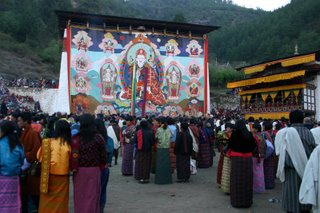 Staying in a new environment and culture, it is difficult to always act in a correct way. I'm sure that I'm insulting people now and then. Sometimes I realize that I'm taking things with the wrong hand, that I'm asking questions the wrong way around, or that I'm just reacting to questions in the wrong way. I realize soon after I have done it - but by the time I have realized it, it has already happened and you can't undo it. Sometimes, I could kick myself a few times every hour, but probably that's just the learning process that you have to go through. It'll take a bit of time to get adjusted and to learn. I'm happy that I'll be staying in Bhutan for four months; this gives me definitely time to get some learning done.
Staying in a new environment and culture, it is difficult to always act in a correct way. I'm sure that I'm insulting people now and then. Sometimes I realize that I'm taking things with the wrong hand, that I'm asking questions the wrong way around, or that I'm just reacting to questions in the wrong way. I realize soon after I have done it - but by the time I have realized it, it has already happened and you can't undo it. Sometimes, I could kick myself a few times every hour, but probably that's just the learning process that you have to go through. It'll take a bit of time to get adjusted and to learn. I'm happy that I'll be staying in Bhutan for four months; this gives me definitely time to get some learning done.I hope that I didn't insult anybody during my time at the Tsechu. Wednesday morning, I went fully dressed up; the last time I have worn those clothes was probably at Coni & Tiisli's wedding. Because an NC hat doesn't match a fully dressed sam, I decided to just forget about the stupid hat - the sun won't be that strong. At the Tsechu, I was the only western guy that was fully dressed up. Was a bit strange; but it is a sign of respect - finally, I'm not staying in Bhutan as a tourist but rather as a person that should respect the local culture. Weather was really nice, the sun was burning, and I couldn't find a place in the shades from which I could have observed the dances. This had the result that after a short period of time, I was badly burned. So I returned back to my place on the NIE campus and changed to a bit more casual clothes; this time with NC hat. After having returned to the Tsechu, I stayed there all afternoon long and observed the dances and the folks hanging around. It was windy and rather dusty; so I was quite happy that I changed to casual clothes.
Tomorrow, I'll be moving to Samtse. It's strange, but I already feel a bit sad that I have to leave NIE Paro. I had a good time here and met a ton of good folks. But I'm sure, it'll be fun to stay at NIE Samtse; so I'm looking forward to get in contact with those folks.
As a last thing, let me mention a pretty exciting event this evening: A truck full of computers arrived at the NIE Paro. This is part of the new computer lab and trainees helped to move them to the lab. I started helping out but they kind of felt that I shouldn't be doing physical work; as a ICT specialist (the teachers didn't help out either...). I tried to ignore that (because I was pretty excited about all those new computers) but the guy loading off the computers didn't want to let me carry one of the computers. So I kind of stupidly was standing around while the trainees were doing the work.
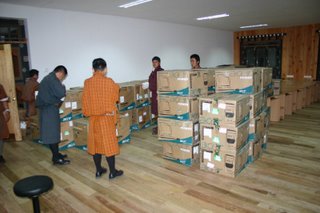
Wednesday, April 12, 2006
Pics: Tsechu and the Paro River
Pics: Arriving, Hotel, and Tsechu
Paro Tsechu - and Adapting to a New Environment
I'm still in Paro. Paro is a nice town - rather small for Swiss or American standards - but huge for Bhutan. During the last few days, Paro has seen a ton of folks; both tourists and local folks. The Paro Tsechu took place during the last four days and will end tomorrow morning. The Tsechu is a religious festival and rather important in the Bhutanese culture. Classes at NIE have been out of session starting Sunday and there was nobody to interact with; therefore I started writing up some of the impression of the first few days. Another task on my schedule was the development of material for a JavaScript class. And for part of today, I've been to the Tsechu. Dressed up ;-). Was a really nice experience; something that you can't find in our culture. Early tomorrow morning, I'll be going another time to the Tsechu place and together with a professor from the IT department, I'll attend a ceremony.
During the last few days, my way of getting around was by feet. It's great to explore a new country that way; especially if most people are walking. Although I realize now and then that Paro is at an altitude of about 2500 meters above sea level.
I'll be going to Samtse (my final destination) this Saturday. Sorry, I'm tired (but internet connectivity is ok only at night..) and this is another time a really chaotic post. I'll improve - give me a bit of time.
Saturday, April 08, 2006
First few days in Bhutan
Classes will be out of session during the next five days; the Paro Tsechu (a local festival) takes place. Because of this festival, I have to move out of my room at the hotel (http://www.dechenhillresort.com/) that I'm currently staying at. During the Tsechu days, I'll be staying in a newly finished guest house on campus. People have been extremely friendly and helped out organizing stuff so that I can stay in that house for a few days. I'll let you know how my time in the guest house turned out ;-). I'm sure it'll be an adventure.
Enjoy life!
Thursday, April 06, 2006
Arrived in Bhutan
Yesterday morning, I arrived in Bhutan. For the flight to Bhutan, I had to getup at 3:40am because my flight left at 5:50am. Flight to Bhutan took maybe four hours and the landing process in Bhutan was kind of scary. As you might know, Bhutan is a mountainous country - so you have to build the airport in the mountains. The wings of the airplane almost touched the mountains - I got really scared. But in the end, we landed safely. Immigration procedures went smoothly and Els (the project manager) picked me up at the airport. We went to the hotel where I was staying for the first night and then to the NIE Paro.
At NIE Paro, I met a ton of folks. It was really nice to get in touch with them and learn about the project that I'll be working on. I start getting a feeling for what it'll be to work on this project but I still cannot 'take' it into my fingers; I'll need a bit more time to get a real feeling for the project.
After having returned to the hotel, I walked down to Paro (my Hotel is a little bit above Paro) - was a 15 minutes walk. A young boy was coming up to me and communicated with me in almost perfect English. I was really surprised. Walking around town, I was easily recognizable as a foreigner; the only guys not
wearing a traditional dress. After having returned to the hotel, I got a really good meal and right after the dinner, I went to bed. What else should I have done: I was extremely tired (slept about 5 hours from Sunday morning to Tuesday evening) and there was no electricity ;-).
Yesterday morning, we drove to Thimphu; the capital. Was about a two hours drive and I realized really fast why I'm NOT allowed to drive a car in Bhutan. But I'll write about that a bit later on.
Yesterday, I had a bunch of meetings at the Helvetas office here in Thimphu. All the initial face-to-face meetings; organizing visa stuff, and just get an introduction into the projects.
Sorry for this chaotic post - that's about how my life currently looks like. All the best from Bhutan.
Monday, April 03, 2006
Stop in Bangkok
Today, I went to the UNESCO office and met with Cedric Wachholz. Cedric is working on ICT&Education. Was a good meeting. I'll keep you posted; tomorrow, I'll be arriving in Bhutan.
